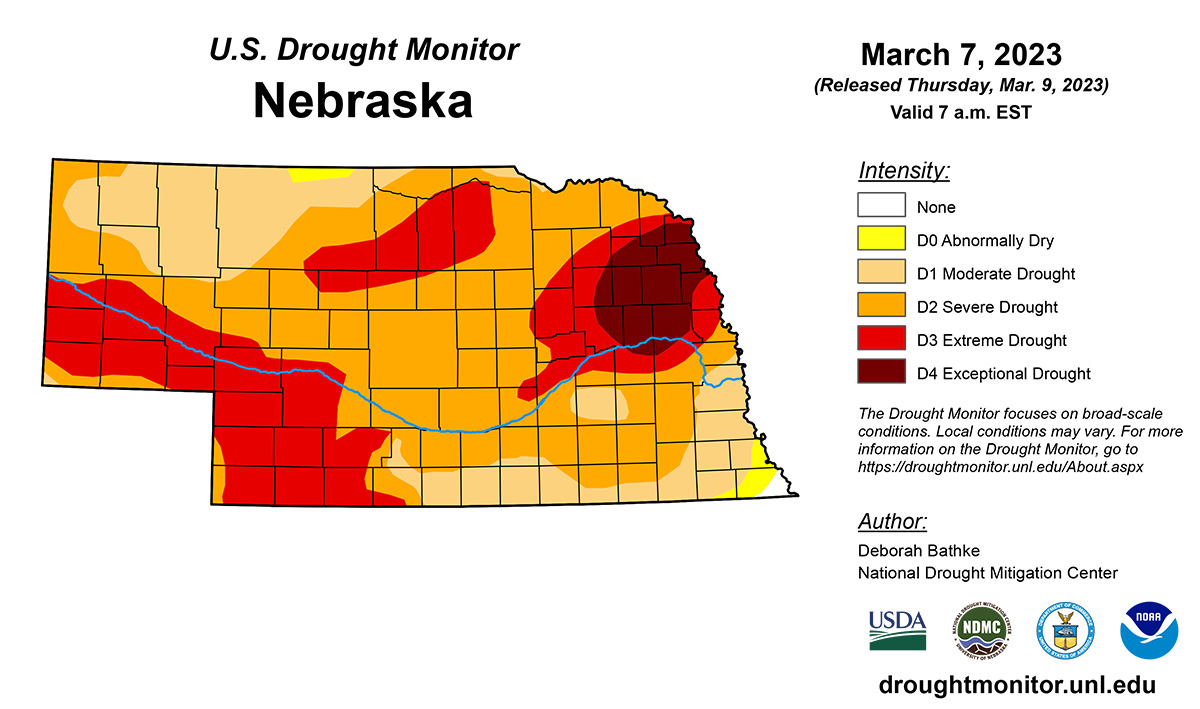The 2023 cropping season is just around the corner. Unfortunately, drought continues to influence nutrient management decisions for the upcoming season, as seen in the latest Drought Monitor map, even with significant snowfall in parts of the state.
The 2022 corn grain yield in Nebraska was reported at 1.46 billion bushels (USDA’s National Agricultural Statistics Service), down 22% from 2021. The 2022 average corn yield was 165 bushels/acre, down 29 bushels from 2021. Lower yields in 2022 were likely due to hot and dry growing conditions as well as hail events. These conditions might have reduced crop nitrogen uptake, leaving higher-than-normal residual nitrogen in many growers’ fields. Drier conditions could also reduce nitrogen losses through leaching or denitrification, resulting in a build-up of nitrogen from the mineralization of soil organic matter. Residual nitrogen (see below on residual N testing) should be accounted for and used at “no cost” to help supply the nitrogen needs of the next fertilized crop. This will help to reduce the cost of N fertilizer applied, especially when the prices for nitrogen fertilizer are higher than a couple of years ago.

If you plan soybean following last year’s corn, then no N fertilizer management would be desired. However, if you plan corn-on-corn and applied normal amounts of N fertilizer to corn in 2022 corn, but had a low yield, a significant amount of residual nitrogen is likely available for the 2023 corn crop. Therefore, the University of Nebraska-Lincoln recommends a lower N application rate when you account for residual nitrate-nitrogen in the N fertilizer prescription for the 2023 growing season. Here we provide an example of N recommendation with and without accounting residual N in the N recommendation. Table 1 provides a comparison of N recommendations with vs. without residual N credit. In this example, growers can save $27 per acre by crediting 36 pounds of N per acre (see Table 1). Of course, the saving can vary across the grower’s field, owing to previous crop, precipitation pattern, geographical location and irrigated vs. dryland fields.
How to Sample Soil, and Test and Utilize Residual Nitrogen for 2023 Crop
Accurate soil sampling and testing is a critical step in knowing residual N and adjusting soil fertility levels in the field. To estimate residual N, sample the soil at 24 inches, although 36 inches or 48 inches is preferable to better capture nitrate present in the soil profile following dry conditions. These cores should be split into 1-foot increments instead of mixing together into one sample to give a better understanding of where nitrate is present in the soil profile. Cores should be air dried, refrigerated, or frozen if they can’t be submitted with 24 hours to a soil testing lab for soil nitrate-N analysis.
A sample consisting of six to eight soil cores for deep samples should be collected to represent no more than 40 acres if fields are uniform. However, drought conditions often result in uneven yields across fields depending on soil types and landscape position. In fields with soil and yield variability, consider doing the soil sampling by zones within the field to better capture the patterns of residual nitrate-N. Yield monitor data, digital soil maps, and elevation are some of the data layers that could be used to identify zones for nitrate sampling.
More information can be found in our extension circular, "Soil Sampling for Precision Agriculture” — EC 154. The residual soil nitrogen values can be entered into the university’s N recommendation equation to adjust the soil N recommendation. More information can be found in our extension circular, “Fertilizer Suggestions For Corn”.
Summary
With the continued drought, a considerable amount of residual nitrogen is likely left from the previous corn crop that can save the cost of N fertilizer for corn-on-corn scenarios in the 2023 growing season. With the higher fertilizer prices, such fertility adjustments for the next crop can be profitable as well as environmentally friendly. We recommend soil testing to account for all sources of nutrients for the upcoming crop.







